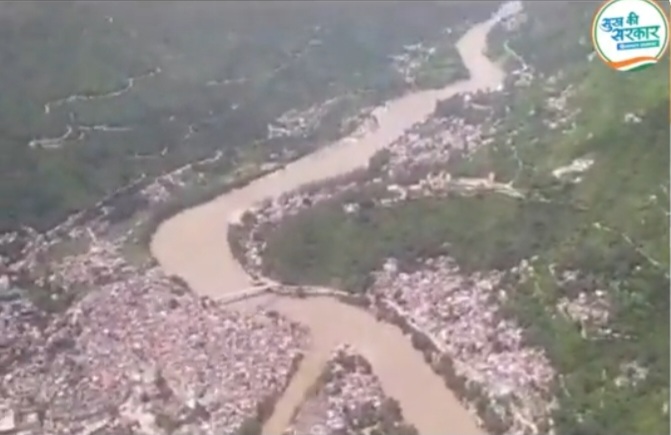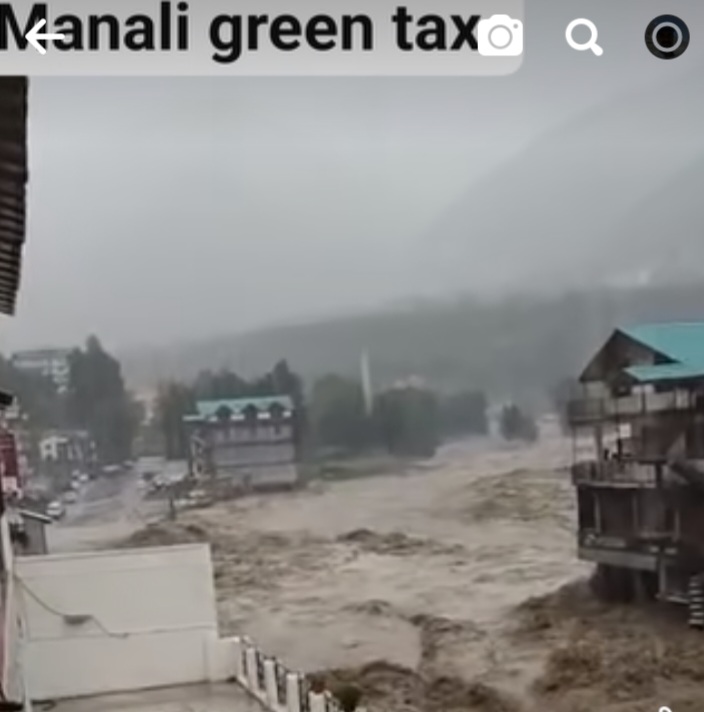SHIMLA/MANALI: It was a convergence of biblical proportions - an unprecedented heavenly Sangam where the South-West Monsoons collided with the one from Bay of Bengal over the skies of Himachal Pradesh from July 9 to 11. All that unleashed here, it reminds people of Manali of an “epic deluge” from which this tourist town was once believed to have emerged in a distant 'Bhootkal'.
But what seemed like a celestial spectacle turned into a nightmarish catastrophe, as this divine alliance broke all hell loose upon the Dev Bhoomi, leaving behind broken roads, breached banks, flooded houses and deluged river basin from Bahang to Mandi.
The surging Beas river washed away the national highway stretch from Raison to Manali including the Manali Bypass as this section is built right near the what the then British had labelled as the Fishing Point of the river.
With relentless fury, the heavens unleashed torrential rains and merciless cloud bursts upon the Kullu-Parbati-Manikaran-Gheerganga valleys, Mandi, Nahan and all over Himachal Pradesh-. Nahan recorded highest 232mm of rainfall and others ranged from 130 mm to 198 mm.
The consequences of this “Divine alliance with local conditions” were clear that everybody saw.
An avalanche of incessant rains and flash floods battered the already wounded hills and saturated watersheds of Himachal Pradesh.
The saturated water sheds of Solang, Manasu, Beas Nala, Allain and Duhangan in Manali region and Servari, Parbati, Gheerganga, Malana, Tosh, Pulga rivers and streams in Parbati valley became inundated in a deluge of grave intensity.
The water sheds were already saturated even before Monsoon gained its intensity in first week of July. Farmers saw their fields growing with green grass even under a thick cover of snow in peak winter when every green thing looks dry and dead in mountains!
In the heart of this chaos lay the mighty Beas River, a force of nature yearning for taming.
In fact, the Beas river channelisation project remains dumped in the files of rechristened Jal Shakti Vibhag.
The absence of proper channelization proved to be a ticking time bomb, as the floods roared with unforgiving force, breaching banks and boundaries, inundating river-side roads, bridges, and homes from Manali to Bhuntar, Aut, Thalot, Larji, and Pandoh.
The devastation spared nothing in its path. The Sainj river, a tributary which joins Beas at Larji , washed away 30 houses and 40 shops in Sainj valley. In all as many as 600 houses/sheds buildings were washed away or flooded.
The blame game ensued in yet another avalanche of articles in Mainstream media and social media from armchair writers, sitting in the comfy rooms in Delhi and elsewhere, with fingers pointed at power projects, dams, unbridled tourism, unplanned constructions and violations of Laws.
But the mainstream media missed the bigger picture, the true culprit - the cataclysmic convergence of two powerful weather systems. The sheer volume of water from the Beas and Satluj rivers alone could have spelled doom for downstream towns and villages as far as Punjab.
Amidst the chaos, unsung heroes emerged in the form of dams and barrages like Larji, Pandoh and Pong dam on the Beas and Kol dam and Gobind Sagar (Bhakhara) on the Satluj river.
Their presence mitigated the destruction, pacifying the furious Beas and Satluj rivers and saving countless lives.
The downstream communities owe their survival to these silent guardians, protecting them from the surging untamed rivers.
See what had happened in world’s worst disaster in China when over 3.7 million people died in the flood in the Yangtze river in 1931. The river has been tamed and dammed by China.
But amidst the cacophony of destruction, the main stream media's attention turned to the “man-made planned causes, overlooking the undeniable reality.
The flash floods hotspots like Manali and Parvati valleys were starved of crucial rainfall data as there is no weather stations in Manali and Manikaran. SeoBagh and Bhuntar weather stations remained malfunctioned, so was the case with Kukumseri in Lahaul that paints the picture of IMD Centre.
We may not know exactly how much was the rain fall, but locals say it was the wettest and the heaviest ever 24 hours in Manali they know to date. The Beas river swelled to over 60 ft higher than its flood level, poured down breaching its banks in the absence of its channelisation.
Bhuntar bore the brunt of nature's fury, as the Beas River collided with the surging Parbati River here and other tributaries like Allain, Duhangan, Servari joined Beas before this town.
The ensuing wrath surpassed imagination, leaving behind banks filled with boulders and sands and despair in its wake.
Only the wider riverbanks between Kullu and Bhuntar offered a glimmer of hope, preventing a complete annihilation.
As Himachal Pradesh grapples with the aftermath of this heart-wrenching disaster, the urgent need for proper river channelization and disaster preparedness looms large.
Lives have been shattered, families torn apart, and dreams left in ruins by the unforgiving forces of nature, but the death toll was small as compared with the past worst disasters.
The time for blame games is over; action must replace complacency.
Himachal Pradesh must rise from the debris, forging a safer and resilient future. The Flood plains and boulders must belong to the rivers. Cost of neglect is measured in human lives and dreams lost forever.







